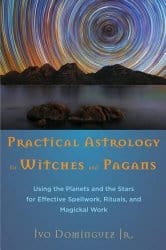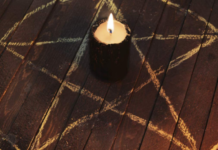
 Practical Astrology for Witches and Pagans: Using the Planets and the Stars for Effective Spellwork, Rituals and Magickal Work, by Ivo Dominguez Jr.
Practical Astrology for Witches and Pagans: Using the Planets and the Stars for Effective Spellwork, Rituals and Magickal Work, by Ivo Dominguez Jr.
Weiser Books, 9781578635757, 216 pp., 2016
I have always been intimidated by astrology. It’s been a lifelong interest but my study of it never went beyond learning some fundamentals about star signs. The many times over the years that I have picked up a book with the intention of finally educating myself about astrology, my resolve faded the minute complexities were raised, like houses, charts, ascensions, ruling planets or aspects. It all seemed too complicated. I’m so happy to report that Ivo Dominguez Jr. has my views with this book!
Ivo Dominguez Jr. has written a number of books, and has served as a priest, teacher and leader in Wiccan community for many years. Practical Astrology for Witches and Pagans achieves a wonderful balance by taking the reader gently through complex topics, reassuring the reader that the information is practical, and making the theoretical accessible. Dominguez Jr. looks at astrology as one of many tools in an esoteric spiritual toolbox, such as crystals, tarot or candles. The reader is encouraged to take small steps in learning astrology, starting with learning the glyphs for the signs, and understanding the basics of signs and houses.
The author makes it clear that he is teaching the reader the basics that will be useful for practical purposes. There is no expectation that the reader will come away with the ability to create a chart — many other resources exist for that purpose, in addition to free websites that will cast a chart for you. In making the material actually practical, Dominguez Jr. removes the intimidation factor and motivates you to learn more and tackle some of the more complex concepts.
At the start of the volume, there is a wonderful guided visualization of a celestial temple that the reader is to enter. The visualization describes a stained glass ceiling with 12 panels depicting the signs; and the planets beyond illuminating the panels, which are projecting shifting images onto the floor; divided into 12 houses that would be analogous to a person’s astrological chart. It’s a beautiful representation that makes complex ideas simple, and he returns to it throughout the book.
The basics of the signs, houses and aspects are explained in simple terms that make it easy to understand. The reader is then given ideas about how to incorporate these relatively simple ideas into ritual — using the glyphs or combinations of glyphs to represent either people, or gods or qualities, and meditating on planets and their characteristics. He creates correspondences between planets and the kabbalistic tree of life, plus spirits and angels. It becomes clear that one doesn’t need to create a complicated chart in order to make use of astrology as a tool for ritual, spellwork, or meditation. Basic knowledge and a little creativity are all that is required.
Moving along, there is information about how to maximize ritual or spellwork by making strategic use of time — either times associated with particular signs or planets that are pertinent to ones work, or just being aware of which astrological elements are at play when one is working. Dominguez Jr. skilfully incorporates hermeticism. These elements of time are woven in with theories on the kabbalah , and demonstrates how anyone working with the kabbalah can easily incorporate astrological elements. There is an image of how the planets align with the Star of Time and Eternity, a seven-point star that makes meaningful connections between the sephiroth and the seven elder planets.
Charts are used mostly for illustration, for example, Emily Dickinson’s and Aleister Crowley’s charts are reproduced for illustrative purpose. The reader is encouraged to create a chart if they have those skills, or to seek one out from an astrologer or online, to help elucidate the concepts presented.
The concept of modalities is introduced early on (signs being cardinal, fixed or mutable), and their elemental relationships. Later, these ideas are developed further, in discussion of how the modality and element contribute to one’s aura. These influences can also be useful in ritual and spellwork. One of the final chapters concerns magick squares, a concept which was entirely new to me. Evidently they are ancient magical tools incorporated into kabbalah, planetary and ceremonial magick, which use the language of mathematics. The topic is not at all typical of astrologic texts, nor did I find it easily accessible. I do admire the way the author takes the reader from confidence in simpler concepts to a progression to ancient, complex astrological ideas that are likely to inspire ongoing learning.
The appendices include references for planet and sign correspondences in chart form which are excellent and very helpful, with additional information regarding the houses, magick squares for the seven elder planets, and more.
Practical Astrology for Witches and Pagans is a book to grow with. I would highly recommend it for witches or Pagans who seek to both learn more about astrology, and who wish to learn techniques for incorporating astrological concepts into ritual in an accessible way.








